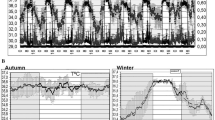Abstract
Survival and degree of cold adaptation were determined for Swiss Webster and Connaught strain white mice exposed to 2°C and caged as follows: (I) a single animal in an empty plastic cage; (II) a single animal in a plastic cage containing bedding material; (III) 2 animals in an empty wire-mesh cage, and (IV) 3 animals in a plastic cage containing bedding material. After 10 days of exposure under these conditions, survival was 54, 62, 87 and 94% in Swiss Webster, and 87, 100, 92 and 92% in Connaught mice. When the degree of cold adaptation was estimated on the basis of the average decrease in core temperature during a 45-minute exposure to -10°C, values of 4.4 (I), 5.1 (II), 4.2 (III), 6.8 (IV) and 11.0°C (control) were determined for Swiss Webster mice, and 1.7 (I, II and III), 3.2 (IV) and 9.0°C (control) for Connaught mice. The study revealed that there are significant intrastrain differences in the ability of small mammals to both tolerate and adapt to a cold stress.
Zusammenfassung
Die Überlebensrate und das Ausmass der Kälte-adaptation von Mäusen des Swiss-Webster und Connaught Stammes wurden während 2°C-Kälteexponierung bei folgender Haltung bestimmt: (1) einzeln in leeren Kunststoffkäfigen; (2) einzeln in Kunststoffkäfigen mit Einstreu; (3) 2 Tiere in Drahtkäfig und (4) 3 Tiere in Kunststoffkäfig mit Einstreu. Nach 10 Tagen überlebten unter diesen Bedingungen von den Swiss-Webster Mäusen 54, 62, 87 und 94% und von den Connaught-Mäusen 87, 100, 92 und 92%. Die Abschätzung der Kälteadaptation aus dem mittleren Abfall der Kerntemperatur nach 45 Min bei -10°C ergab bei den Swiss-Webster-Mäusen 4,4; 5,1; 4,2 und 6,5°C und 11, 0°C bei den Kontrollen während bei den Connaught-Mäusen die Senkung nur 1,7°C (1, 2, 3), 3,2° (4) und 9,0°C bei den Kontrollen betrug. Danach bestehen signifikante Unterschiede in der Kältetoleranz und der Anpassungsfähigkeit zwischen den beiden Mäusestämmen.
Resume
On a examiné le taux de survie et d'adaptation au froid de souris blanches des races Swiss-Webster en Connaught placées à 2°C dans les conditions suivantes: (1) bêtes isolées dans des cages de plastique vides; (2) bêtes isolées dans des cages de plastique pourvues d'une litière; (3) ensemble de deux bêtes dans des cages grillagées vides et enfin (4) ensemble de trois bêtes dans des cages de plastique pourvues d'une litiére. Après 10 jours, le taux de survie fut de 54, 62, 87 et 94% chez les souris Swiss-Webster et de 87, 100, 92 et 92% chez les souris Connaught. Le degré d'adaptation au froid a été estimé par l'abaissement de la température centrale après exposition de 45 minutes à -10°C. Les résultats furent: Swiss-Webster 4,4, 5,1, 4,2 et 6,5°C (11,0°C pour des bêtes de contrôle); Connaught 1,7, 1,7, 1,7 et 3,2°C (9,0°C pour le contrôle). Il en résulte que la tolérance au froid et les facultés d'adaptation sont différentes pour ces deux races et cela de façon significative.
Similar content being viewed by others
References
HAYWARD, J.S. (1965): Microclimate temperature and its significance in six geographic races of PEROMYSCUS. Canad. J. Zool., 43: 341–350.
LEBLANC, J. (1967): Adaptation to cold in three hours. Amer. J. Physiol., 212: 530–532.
OGILVIE, D.M. (1967a): Adaptation of white mice (MUS MUSCULUS) to repeated cooling. Can. J. Zool., 45: 321–327.
OGILVIE, D.M. (1967b): Cooling at −10°C as an index of cold acclimation in white mice. Canad. J. Physiol. Pharmacol., 45 : 748–752.
PEARSON, O.P. (1960): The oxygen consumption and bionergetics of harvest mice. Physiol. Zool., 33: 152–160.
PRYCHODKO, W. (1958): Effect of aggregation of laboratory mice (MUS MUSCULUS) on food intake at different temperatures. Ecology, 39: 500–503.
SCHMIDT-NIELSEN, K. (1964): Desert Animals. Oxford University Press, London.
SEALANDER, J.A. (1952): Survival of PEROMYSCUS in relation to environmental temperature and acclimation at high and low temperatures. Amer. Nat., 46: 257–311.
Author information
Authors and Affiliations
Additional information
This paper is based on research conducted at Defence Research Establishment Toronto, Downsview, Ontario (DRET Research Paper No. 680).
Rights and permissions
About this article
Cite this article
Ogilvie, D.M. Behavioural thermoregulation and cold adaptation in two strains of white mice. Int J Biometeorol 14, 285–291 (1970). https://doi.org/10.1007/BF01742072
Received:
Issue Date:
DOI: https://doi.org/10.1007/BF01742072




